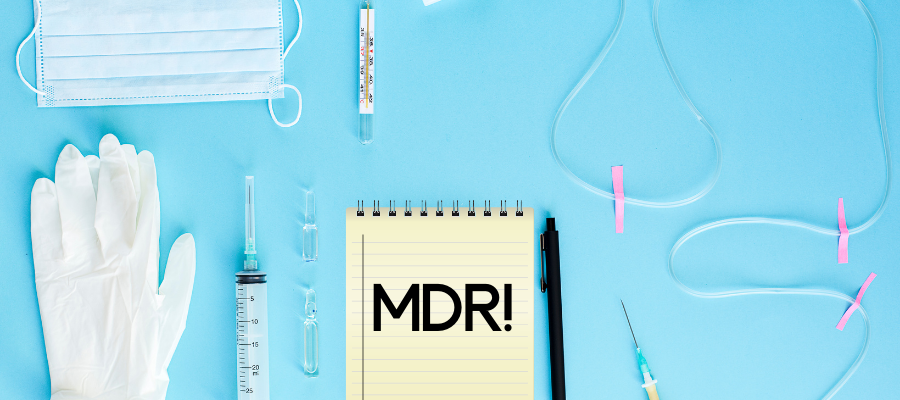
[Blog] Summary of Medical Devices Regulation (MDR) – where is changed and what is next?
The transition to MDR is associated with new requirements and changes, which affect the whole industry.
In 2017 the Medical Devices Regulation (MDR) was published and marked the start of a four-year journey of transition from MDD to AIMDD. From the 26th of May 2021, the MDR will be fully applicable. During the transition, the manufacturers should have informed themselves and took into consideration the changes and certificates that are needed according to the new Regulation. In general, the MDR affects the industries of manufacturing, distribution or procuration of medical devices. It is good to be marked that no existing requirements have been removed, but what has changed? We outlined the key areas with new requirements.
First of all, the scope has broadened – some devices fall within the scope of the Regulation compared to the Directives. Other medical devices have been excluded as in vitro diagnostic medical devices (Regulation (EU) 2017/746), advanced therapy medicinal products (Regulation (EC) No 1394/2007), cosmetic products covered by (Regulation (EC) No 1223/2009) and others. The full exclusion list is in paragraph 6 of MDR. The situation with the combined devices (medical device and in vitro diagnostic device or medicinal product) is essential and for them apply specific rules. Last one, the online sales of devices and services also fall under the Regulation`s scope.
Moreover, the definition of a medical device is modified, and some new definitions are added as Unique Device Identifier (UDI), clinical data, clinical evidence and a serious incident.
There are a few changes in the obligation of manufacturers which affect the risk management, quality management, clinical evaluations, technical documentation, assessment procedure, financial responsibility system (in case of harm caused by defective device). Also, it is obligatory for every manufacturer to have a responsible person for regulatory compliance. After the accomplishment of the pointed obligations, the manufacturers must draw up a declaration of conformity (Article 19) and apply CE marking to the produced devices (Article 20). About the manufacturers who are not established in the Member State of EU, the device may only be placed on the Union market if the manufacturer designates a sole authorized representative (Article 11).
As we already mentioned, the classification of the device is of great importance and is affected by MDR. 22 rules are set out for determining risk classes, which you can find in Annex VIII.
Under the new Regulation, notified bodies should be designated. They play a key role as a responsible party. Its obligations are to audit the quality management system of the manufacturer, perform surveillance audits, review the technical documentation of devices, as well as to carry out and issue conformity assessments.
With regard to global traceability, all manufacturers are responsible to place a Unique Device Identifier (UDI) on the label of the medical devices or on its packaging, which is a new feature of the Regulation. There is an exclusion – if the device is reusable, the UDI has to be on the device itself but in this case, the timeline of implementation is in 2023.
More about Unique Device Identifier (UDI) >>
The conformity assessment procedure is also affected by substantial changes. The manufacturer can affix CE marking on the medical devices, only if the conformity assessment is successful which means that the general safety and performance requirements are fulfilled. In some cases a Notified Body is needed, for example for certain devices is required to have a new clinical evaluation consultation procedure, which is carried out by the independent expert panel, but is based on Notified Body`s clinical evaluation assessment report. However, there are also cases where the manufacturers have a choice of how to process the conformity assessment.
It is pointed out that in the area of clinical requirements are some of the biggest changes. Clinical investigation and stringent evaluation requirements are some of the key objectives in the MDR which aim to secure a high level of health and safety protection through transparency and traceability.
What`s next?
The MDR (EU) 2017/745 will apply from 26 May 2021 – the “Date of Application” (DoA). You can check out the Transition Timeline and see how the process is going to continue.
To better understand the implementation dates of the forthcoming MDR and IVDR regulations, you can benefit from our Ultimate Compliance Test.
Sources:
https://www.medical-device-regulation.eu/wp content/uploads/2019/05/CELEX_32017R0745_EN_TXT.pdf
https://ec.europa.eu/health/sites/default/files/md_newregulations/docs/md_manufacturers_factsheet_en.pdf
https://www.pharmiweb.com/article/class-ii-eu-mdr-regulation-is-just-around-the-corner-why-class-iii-compliance-efforts-provide-a-wa
https://manufacturingchemist.com/news/article_page/The_EU_MDR_2021_countdown_to_compliance/172207
https://www.obelis.net/notified-body-services/
https://ec.europa.eu/health/sites/default/files/md_topics-interest/docs/md_faq_udi_en.pdf
https://www.regulatory-affairs.org/en/clinical-affairs/news-page/conformity-assessment-procedures-for-medical-devices/
